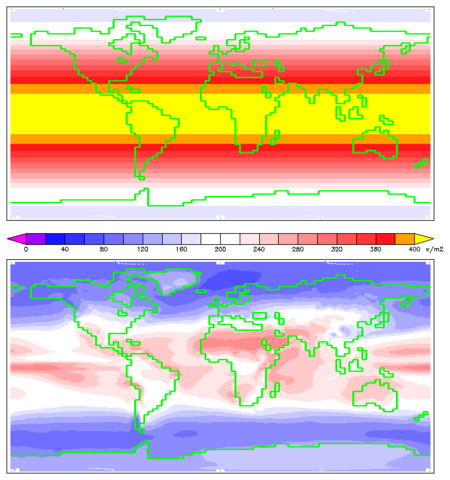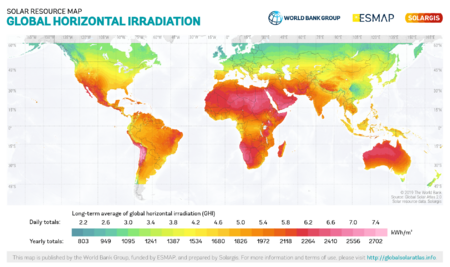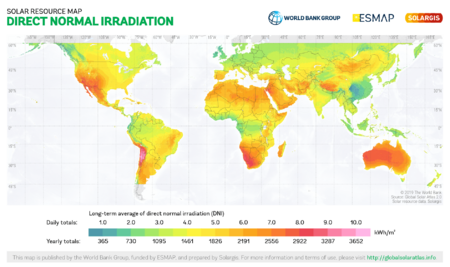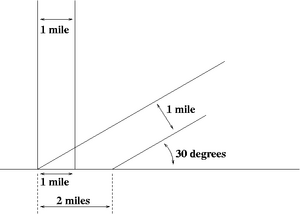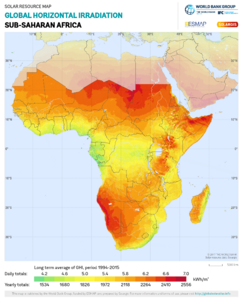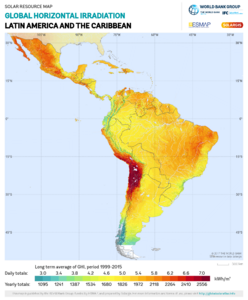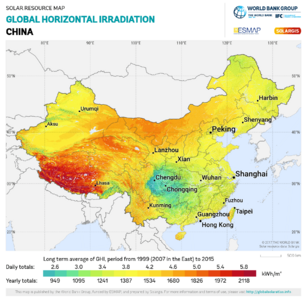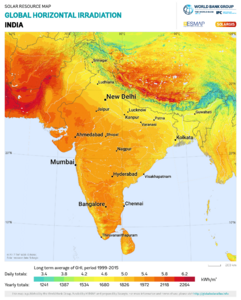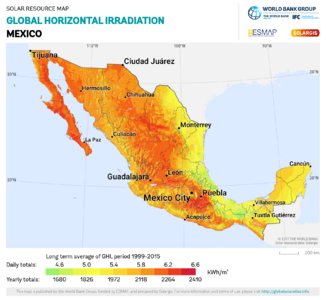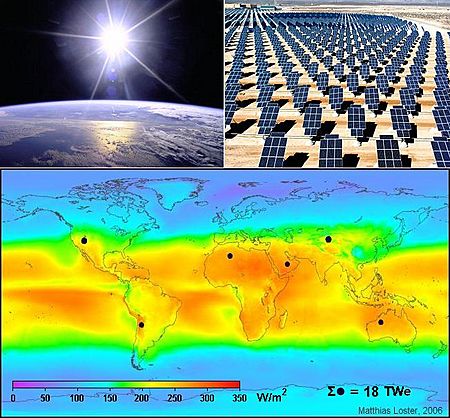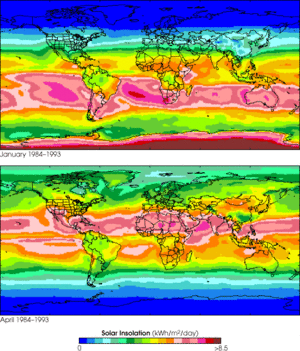Solar irradiance facts for kids
Solar irradiance is the amount of power from the Sun that hits a certain area. This power comes in the form of electromagnetic radiation, which includes all kinds of light, like the light we can see. It's measured in watts per square metre (W/m2).
When we talk about solar irradiance over a period of time, like a day or a year, we call it solar irradiation or insolation. This tells us the total amount of solar energy received.
Scientists measure solar irradiance both in space and on Earth's surface. In space, it changes based on how far Earth is from the Sun and the Sun's own activity cycles. On Earth, it also depends on things like how the surface is tilted, how high the Sun is in the sky, and the weather. Solar irradiance is super important because it affects how plants grow and how animals behave.
Studying and measuring solar irradiance helps us in many ways. For example, it helps predict how much energy solar power plants can make, how much heating or cooling buildings need, and how to understand climate and weather. It's also key for space travel.
Contents
Types of Solar Irradiance
There are different ways to measure solar irradiance:
- Total solar irradiance (TSI) is the total power from the Sun that hits the Earth's upper atmosphere. It's measured straight on, meaning the measuring device is pointed directly at the Sun. The solar constant is the average TSI at Earth's distance from the Sun.
- Direct normal irradiance (DNI) is the sunlight that comes straight from the Sun to a spot on Earth. It doesn't include light that's scattered by the atmosphere. DNI is what's left after the atmosphere absorbs or scatters some of the Sun's rays. Things like the time of day, cloud cover, and moisture in the air affect DNI.
- Diffuse horizontal irradiance (DHI) is the sunlight that reaches Earth's surface after being scattered by the atmosphere. This is the light that comes from all parts of the sky, not directly from the Sun. If there were no atmosphere, there would be almost no DHI.
- Global horizontal irradiance (GHI) is the total sunlight that hits a flat, horizontal surface on Earth. It's the sum of direct sunlight (DNI) and scattered sunlight (DHI).
- Global tilted irradiance (GTI) is the total sunlight received on a surface that is tilted at a specific angle, like a solar panel.
- Global normal irradiance (GNI) is the total sunlight hitting a surface that is always pointed directly at the Sun.
Units of Measurement
The standard unit for irradiance is watts per square metre (W/m2). For solar power, people often use kilowatt hours per square metre (kWh/m2).
Another unit sometimes used for insolation is the Langley. One Langley is equal to 41,840 J/m2.
Sunlight at the Top of the Atmosphere
On average, about 1361 W/m2 of solar radiation reaches the top of Earth's atmosphere. This is the power hitting a circular area the size of Earth as seen from the Sun.
Because Earth is a sphere, this energy gets spread out over its entire surface. So, when averaged over the whole Earth, the amount of solar radiation received at the top of the atmosphere is about 340 W/m2. This number is important for understanding Earth's energy balance.
How Sunlight Changes
The total solar irradiance (TSI) changes a little over many years. For example, it varied by about 0.1% during one solar cycle (a period of about 11 years). Over longer periods, like from the 17th century to now, TSI has increased by a very small amount, about 0.05% to 0.1%.
Some changes in sunlight reaching Earth are not because the Sun changes, but because Earth's orbit changes. These orbital changes, called Milankovitch cycles, can cause big differences in how much sunlight different parts of Earth receive over thousands of years. For example, they can cause changes as large as 25% in certain areas over long periods.
Measuring Sunlight from Space
Scientists use special instruments called radiometers on satellites to measure TSI. These tools are very precise and measure the electrical heating needed to keep a dark cavity warm when sunlight hits it. This helps them track tiny changes in the Sun's energy output.
It's tricky to get perfectly consistent measurements over many years because the instruments can slowly change in space. Scientists use different methods to correct for these changes and make sure their measurements are accurate.
Sunlight on Earth's Surface
When sunlight travels through Earth's atmosphere, it gets weaker. On a clear day at sea level, the maximum direct sunlight is about 1000 W/m2. The total sunlight on a horizontal surface, including scattered light, can be around 1120 W/m2.
On average, the Earth receives about 6 kWh/m2 of sunlight per day. This amount changes depending on the Sun's angle and the weather.
Absorption and Reflection
When sunlight hits an object, some of it is absorbed, and the rest is reflected. The absorbed light usually turns into heat, making the object warmer. However, things like photovoltaic cells (solar panels) or plants can turn this absorbed light into other forms of energy, like electricity or chemical bonds. How much light an object reflects is called its albedo.
The Angle of the Sun
Sunlight is strongest when it hits a surface directly (at a 90-degree angle). As the angle changes, the sunlight becomes less intense. This is because the same amount of sunlight gets spread out over a larger area.
This "projection effect" is why Earth's polar regions are much colder than equatorial regions. The poles receive less direct sunlight on average because they are always angled more away from the Sun. Also, they get no sunlight at all during their long winters.
Atmosphere's Effect
When the Sun is lower in the sky, its light has to travel through more of the atmosphere. This makes the light weaker because the atmosphere absorbs and scatters more of it. This is why the Sun feels less strong in the early morning or late afternoon compared to midday.
Solar Potential Maps
Scientists and companies create maps that show how much solar energy different areas receive. These maps are very useful for planning where to put solar power systems.
- Maps of GHI potential by region and country (Note: colors are not consistent across maps)
These maps are often made using satellite images. They are generally very accurate, especially for showing Global Horizontal Irradiance.
How We Use Solar Irradiance Information
Solar Power
Solar irradiation figures are essential for planning where to put solar energy systems. In many countries, you can find these figures on maps or in tables that show data from the last 30-50 years.
Different solar technologies use different parts of the sunlight. For example, solar photovoltaics (solar panels) can turn both direct and scattered sunlight into electricity. However, concentrated solar power systems need direct sunlight to work well, so they are best in places with clear skies.
Solar panels are usually tilted towards the Sun to get the most energy. This means that a panel at a high latitude (far from the equator) can still receive a good amount of sunlight, even if a flat surface there wouldn't.
Buildings
When designing a building, knowing about insolation is very important. Architects can use the "projection effect" to design buildings that stay cool in summer and warm in winter. For example, windows on the side of the building facing the equator (south in the Northern Hemisphere, north in the Southern Hemisphere) can be designed to let in more sunlight in winter when the Sun is low, and less in summer when the Sun is high.
Civil Engineering
In civil engineering and hydrology, engineers use sunlight measurements to predict how fast snowmelt will happen. This helps them estimate how much water will be released from melting snow. They use a tool called a pyranometer to measure this in the field.
Climate Research
Sunlight plays a big role in climate modeling and weather forecasting. If Earth is taking in more energy from the Sun than it's sending back out, it means our planet is warming up.
Scientists use very stable instruments to measure long-term changes in sunlight. This helps them understand how these changes affect Earth's climate over time.
Global Cooling
Understanding how surfaces reflect sunlight is important for passive daytime radiative cooling. This is a method being explored to help cool down local areas and even the planet. On a clear day, sunlight can be very strong, but special cooling surfaces can reflect a lot of it, helping to lower temperatures.
Space Travel
Sunlight is the main factor that affects the temperature of spacecraft and planets. Knowing about solar activity and irradiance is crucial for designing spacecraft and planning missions. For example, NASA launched the Solar Radiation and Climate Experiment (SORCE) satellite to monitor solar irradiance.
See also
 In Spanish: Irradiación solar para niños
In Spanish: Irradiación solar para niños
- Earth's energy budget
- PI curve (photosynthesis-irradiance curve)
- Irradiance
- Albedo
- Flux
- Power density
- Sun chart
- Sunlight
- Sunshine duration
- List of cities by sunshine duration



